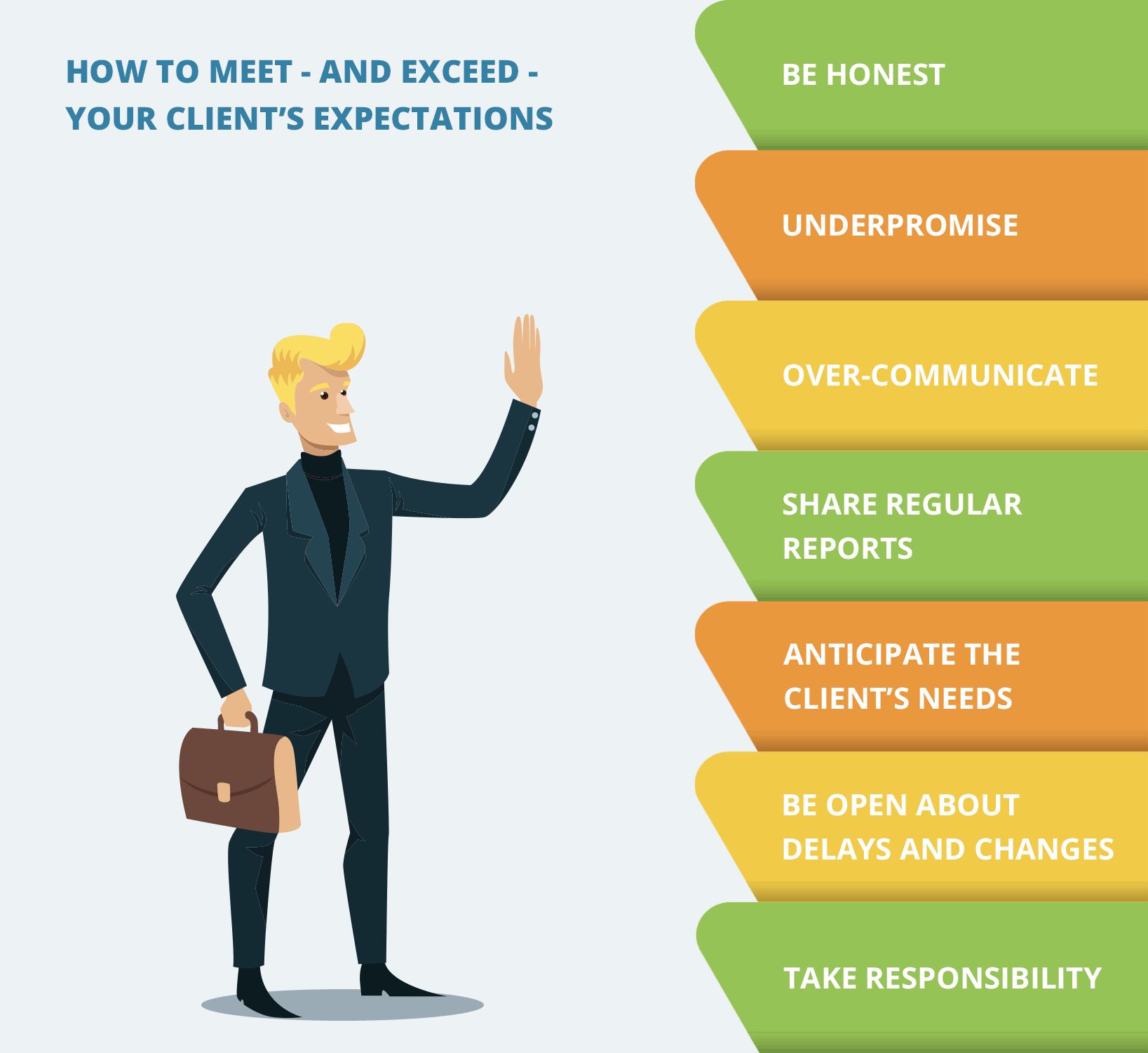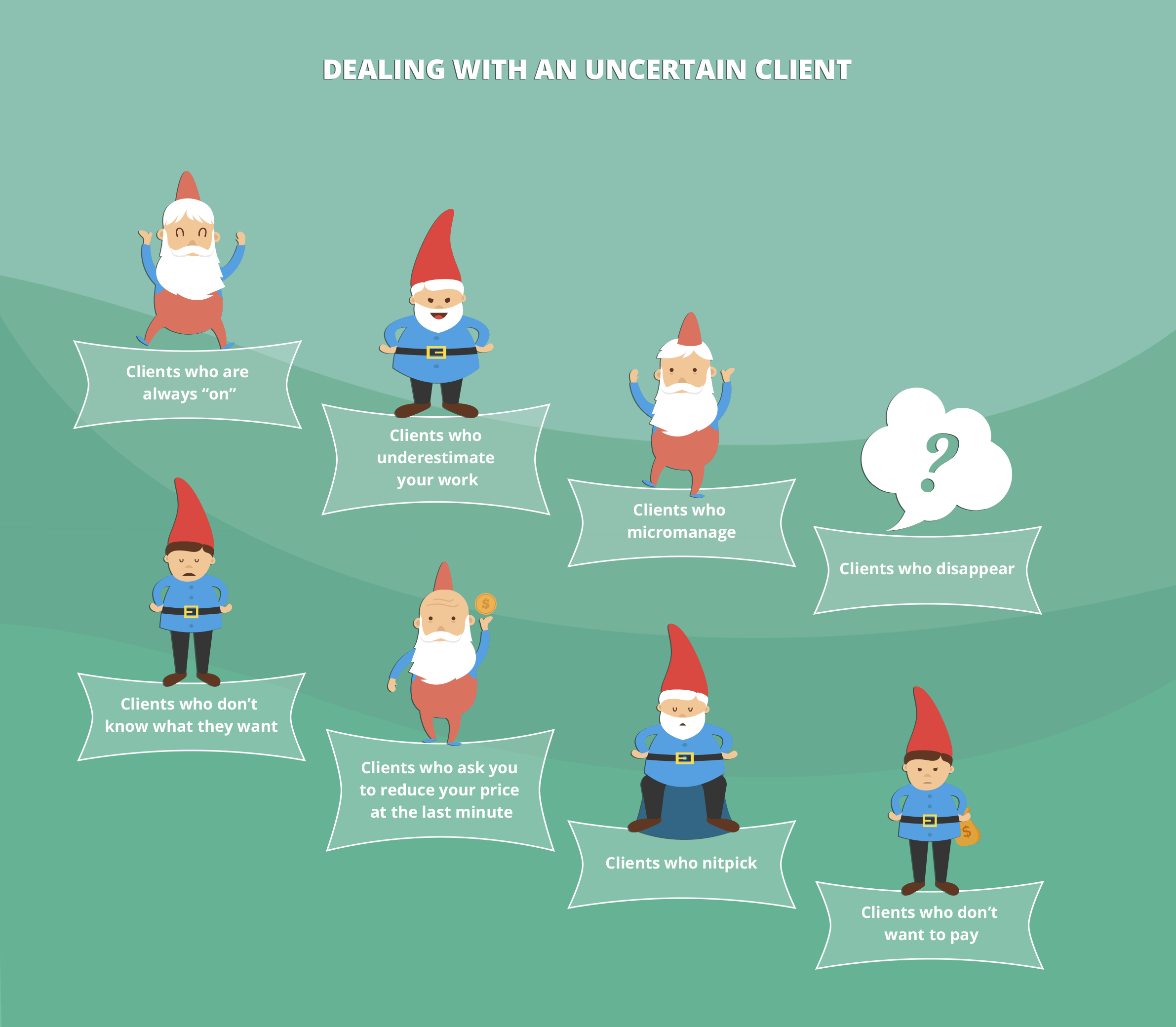- What you will deliver
- When you will deliver it
- How much and when you will be paid
 Be honest. You might not want to tell your client you’ve never coded an app all by yourself before, but you also shouldn’t pretend you’re an expert if you aren’t. Be open about your experience, abilities, and commitment. If you pretend you know it all, you’ll be left feeling embarrassed to ask questions that need to be asked. You’ll also risk having it all blow up in your face if you can’t actually deliver on your grand promises.
Underpromise. This might sound counterintuitive, but it’s a good way to avoid disappointing a client. Set deadlines that allow you more time than you need. That way, even if something goes wrong, you should still be able to deliver on time.
Over-communicate. The more you communicate with your client, the more reassured they will feel. Asking questions shows that understanding the project is important to you. Being quick and happy to respond when the client gets in touch is just as important – your client will feel confident that you aren’t going to suddenly disappear and that their needs matter to you.
Share regular reports. Reports are a tangible way for you to show your client that you’re on top of their project. It could be a formal report showing the progress you’ve made, or just a quick email once a week that summarizes the work you’ve done and explains what you will be focusing on next.
Anticipate the client’s needs. As you gain experience as a freelancer, you’ll come to recognize certain patterns in what clients look for. If you can anticipate your client’s questions before they are asked, you’ll show that you’re able to empathize with their situation and really care about delivering a solution to their problem.
Be open about delays and changes. The best way to handle client expectations is to discuss what to do about delays and changes to the project before you even begin. Ideally, you’ll write clauses into your contract that address what will happen if you miss a deadline or the project needs to be altered. If you hit an unexpected delay, the sooner you notify the client, the better. Discuss the new timeline and project scope, and document any changes this has made to the contract.
Take responsibility. It’s almost inevitable that you’ll let down a client one day, but you still have the chance to handle it well. If this happens, it’s best to acknowledge where you were at fault and take responsibility for your mistakes as soon as possible. Make it clear that you know where you went wrong, describe exactly what you’ll do to fix the issue, and inform the client about the new timeline.
Be honest. You might not want to tell your client you’ve never coded an app all by yourself before, but you also shouldn’t pretend you’re an expert if you aren’t. Be open about your experience, abilities, and commitment. If you pretend you know it all, you’ll be left feeling embarrassed to ask questions that need to be asked. You’ll also risk having it all blow up in your face if you can’t actually deliver on your grand promises.
Underpromise. This might sound counterintuitive, but it’s a good way to avoid disappointing a client. Set deadlines that allow you more time than you need. That way, even if something goes wrong, you should still be able to deliver on time.
Over-communicate. The more you communicate with your client, the more reassured they will feel. Asking questions shows that understanding the project is important to you. Being quick and happy to respond when the client gets in touch is just as important – your client will feel confident that you aren’t going to suddenly disappear and that their needs matter to you.
Share regular reports. Reports are a tangible way for you to show your client that you’re on top of their project. It could be a formal report showing the progress you’ve made, or just a quick email once a week that summarizes the work you’ve done and explains what you will be focusing on next.
Anticipate the client’s needs. As you gain experience as a freelancer, you’ll come to recognize certain patterns in what clients look for. If you can anticipate your client’s questions before they are asked, you’ll show that you’re able to empathize with their situation and really care about delivering a solution to their problem.
Be open about delays and changes. The best way to handle client expectations is to discuss what to do about delays and changes to the project before you even begin. Ideally, you’ll write clauses into your contract that address what will happen if you miss a deadline or the project needs to be altered. If you hit an unexpected delay, the sooner you notify the client, the better. Discuss the new timeline and project scope, and document any changes this has made to the contract.
Take responsibility. It’s almost inevitable that you’ll let down a client one day, but you still have the chance to handle it well. If this happens, it’s best to acknowledge where you were at fault and take responsibility for your mistakes as soon as possible. Make it clear that you know where you went wrong, describe exactly what you’ll do to fix the issue, and inform the client about the new timeline.
Building Strong Client Relationships
Successful freelancers don’t just look at each project as a single job. They view them as stepping stones in their relationship with the client. It’s what keeps your clients coming back to you for more work, and it’s an excellent way to build a steady stream of valuable, well-paying clients. Here are some ways to build positive relationships with your clients:- Show that you care about their interests. If you see a product choice or business decision that you think is harmful, speak up – remember, you are also being hired for your expertise in a particular area
- If appropriate, make suggestions for improving their business that go beyond the scope of your project
- Always suggest the best solutions, even if you won’t benefit from them. For example, if your client wants to pay you to install a next-generation firewall that could interact badly with their existing security software, it’s better to lose the money by telling them this. You’ll only gain in the long-term, by establishing a name for reliability
- Make connections with other freelancers you know who are also on top of their game – by suggesting other excellent workers, you’ll build your own reputation too
- Practice the phone call in advance. Rehearse in your mind what your client might ask you, and make notes about any questions you have for your client.
- Keep the call focused on your client’s needs. Listen more than you talk – remember, your role is to understand your client, not to overwhelm them with your achievements. Even if it’s only an audio call, the client will hear it in your voice, and it will help create an atmosphere of warmth and trust.
- Don’t talk too fast. Some of us tend to speed up when we feel nervous, but that makes it harder for the client to hear you clearly and could create an atmosphere of anxiety and stress, which isn’t the way you want your client to feel.
- Make sure your microphone and speakers work well. Avoid using handsfree as much as possible – it makes your voice harder to hear. If you make a lot of client calls, you might want to invest in a phone headset that has a strong microphone.
- If you’re talking with an ongoing client about a work issue, sum up your information into insights and key takeaways that are easy for the client to grasp.
- End each phone or video call with a clear action point. Either this is something the client needs to do next, or you’ll restate exactly what you are going to do next so the client knows what to expect.
Don’t forget: Client confidentiality is extremely important. When you have a phone or video call with a client, make sure that you’re in a place that is private so people won’t overhear your conversation. If a client calls when you’re in a public place, let them know straight away. They may tell you that it doesn’t matter, but they’ll appreciate knowing you care about protecting their privacy.
How to Deal with Client Issues Without Affecting Your Client Relationship
Even when you have a great relationship with your client, there can still be issues that come up in your working life. If you handle them well, they won’t have any impact on your client relationship, but if managed badly, they could put a real strain on your professional life. Here are five scenarios that could affect your client relationship – and suggestions of ways to handle them so that they don’t.Scenario #1: You’re taking a vacation. Your client might be unhappy that you won’t be available for a week or two. Some clients might get very stressed about the idea of not being able to access your skills during your vacation.
Do: Tell your client several weeks in advance, and ask if there’s any work they’ll need during your vacation that you could do ahead of time. If your client is really nervous that an emergency could arise while you’re unavailable, see if you can find a fellow freelancer who’ll agree to ‘cover’ you while you’re away.
Don’t: Go on vacation without telling your client, and leave an auto-reply on your email that informs everyone you’ll be back in two weeks.
Scenario #2: You’re in a different time zone from your client: You wake up on Monday morning to find 10 angry emails from your client in Australia, demanding the piece of work that was due by midday on Monday. It’s clear to you that there are another four hours to go till midday, but it’s already 6 p.m. in Sydney and the client is missing a different deadline because he hasn’t received your work yet.
Do: Make it clear which time zone applies to deadlines before you begin working for the client, so you both know exactly when your project needs to be completed. Whether you’re three hours ahead or two hours behind your client, discuss this right at the beginning.
Don’t: Assume that every deadline is in your own time zone. It’s even more important not to try to hide which time zone you’re in.
Quick story: I’m five hours ahead of most of my clients. That means I can send a piece of work at the end of my work day, the client can check it over and send me feedback before he leaves the office, and when I start work again the next morning, his feedback is waiting for me to work on before he’s even woken up.
Scenario #3: You don’t work weekends or nights: In today’s smartphone-led culture, many clients expect freelancers to be always on. If you don’t work on the weekends, for example, or after 6 p.m. on school nights, some clients could get angry that you’re lazy or letting them down.
Do: Lay out your regular work hours in your contract. For example, you could tell clients that as a general rule, you’re at your computer from 9 a.m. to 6 p.m., and respond to emails and messages between 8 a.m. and 9 p.m., but that you don’t make any promises outside of those hours. As long as your client knows when and how they can get hold of you, they are likely to accept your hours.
Don’t: Just ignore client emails or phone calls outside of your working hours, or change your working hours without warning.
Scenario #4: Your availability has changed: Perhaps your home life just got a lot more complicated and you need to reduce the number of hours you can work, or you’re facing a sudden expense and you need to increase your work hours. How do you communicate this change to your client without damaging your relationship?
Do: Give the client as much advance notice as possible. This is especially critical when you’re reducing your available hours. If you can, explain the reason for the change so that they don’t think that you’re being irresponsible or lazy.
Don’t: Be abrupt or harsh when you tell your client about the change in your hours. It’s important to remember that your client has been relying on you, and your workload changes could cause a ripple effect throughout the company.
Scenario #5: Your client wants you to work only for them: Some clients like to know that they have exclusive access to your skills. They ask you to drop your other clients or to sign a contract promising you won’t take on any other client in their industry.
Do: Your response will depend on whether or not you’re happy to accept their request. If you love this client, and the client has enough work to make up for the other clients that you’ll be dropping, go ahead and agree. But remember to give your existing clients fair warning – usually 30 days – that you’ll have to end your commitment to them. Tell your exclusive client that there will be a delay of 30 days before you can begin your exclusive work period.
Don’t: Promise to work exclusively for them, but keep other clients secretly on the side. No matter how sure you are that they won’t find out, they still could. Don’t forget to write this exclusivity into the contract, along with what will happen if they can’t provide you with enough work to make the exclusivity clause worth your while.

How to Handle Every Type of Client
It would be great to say that there are no difficult clients, but that wouldn’t be quite true. Some clients will be easy to work with and a joy to help. Others won’t be. Sometimes, you’ll encounter a client who is simply rude, obnoxious, and unpleasant, but this doesn’t happen that often. It’s much more likely that you’ll have to deal with demanding clients who need to be handled with a bit more tact. Here are some tips for dealing with different types of clients. Clients who don’t know what they want. It’s exhausting to have to do the client’s work as well as your own, but sometimes that’s exactly what you’ll need to do to make your work easier. Make sure to put every element of the project in writing, because this client is also likely to change their mind halfway through and ask for something different.
Clients who underestimate your work. These are clients who think the project is really easy. They expect that it will only take a few hours and they aren’t willing to pay for more. In these cases, it’s best to clearly talk them through the project. Break it down into individual tasks and ask them to estimate how long each one will take. Be as detailed as possible. Ultimately, remember that you are a professional. Any client who refuses to accept that your work is on a professional level isn’t a serious client.
Clients who ask you to reduce your price at the last minute. Bargaining for the best possible deal is human nature, but it’s very frustrating for freelancers. What do you do when you spend time discussing a project with a client, and just as you’re about to sign the contract, the client asks for a lower price? That’s when you really test your resolve. You know you’ve set a fair price that accurately reflects the value you bring to the project. Stick to your price, or walk away.
Clients who nitpick. It can be pretty upsetting to have someone tell you every single minor issue that they don’t like about your work, but it can be part of being a professional. Don’t take it personally, and try to stay calm. With this type of client, it’s best to keep them up to date about every detail of the project so that if they criticize it later, you’ll be able to show that they already approved it.
Clients who disappear. These are often clients who are enthusiastic about the project and happy with your work, but when you need more information or approval for the next decision, they are simply unresponsive. Sometimes, they are just disorganized, sometimes they are overstretched, and sometimes your project isn’t important enough to get a reply within a reasonable amount of time. To deal with these clients, you’ll need to be prepared. Your contract should include what raw data or assets the client has to provide for you, and deadlines for them to be sent. Keep track of every time that you tried to communicate with them – ideally, do it through email so you have a record of each attempt.
Clients who micromanage. These are the clients who tell you a better way to do everything. They know more about design, writing, accounting, web developing, etc. than you do and they make sure to tell you that. The only way to manage them is to detach yourself from the project. Accept the fact that you’ll just have to follow their instructions, and make sure you have everything in writing in case someone else questions the final product.
Clients who are always on. These individuals are the ones who work tirelessly and believe that everyone should respond to emails at 2 a.m. Just ensure that you maintain strong boundaries with these clients. Clearly communicate your availability from the outset and resist the temptation to address emails labeled as “Urgent” if they are sent beyond those hours.
Clients who don’t want to pay. Well, this is why you have a contract. As well as setting dates for payment, you should also include a provision for clients who don’t pay on time. This could be a late payment fee, negative reviews on a freelancing platform, or another penalty. If necessary, and if local law permits it, make it clear that you’ll take them to court in your country if they still refuse to pay.
Clients who don’t know what they want. It’s exhausting to have to do the client’s work as well as your own, but sometimes that’s exactly what you’ll need to do to make your work easier. Make sure to put every element of the project in writing, because this client is also likely to change their mind halfway through and ask for something different.
Clients who underestimate your work. These are clients who think the project is really easy. They expect that it will only take a few hours and they aren’t willing to pay for more. In these cases, it’s best to clearly talk them through the project. Break it down into individual tasks and ask them to estimate how long each one will take. Be as detailed as possible. Ultimately, remember that you are a professional. Any client who refuses to accept that your work is on a professional level isn’t a serious client.
Clients who ask you to reduce your price at the last minute. Bargaining for the best possible deal is human nature, but it’s very frustrating for freelancers. What do you do when you spend time discussing a project with a client, and just as you’re about to sign the contract, the client asks for a lower price? That’s when you really test your resolve. You know you’ve set a fair price that accurately reflects the value you bring to the project. Stick to your price, or walk away.
Clients who nitpick. It can be pretty upsetting to have someone tell you every single minor issue that they don’t like about your work, but it can be part of being a professional. Don’t take it personally, and try to stay calm. With this type of client, it’s best to keep them up to date about every detail of the project so that if they criticize it later, you’ll be able to show that they already approved it.
Clients who disappear. These are often clients who are enthusiastic about the project and happy with your work, but when you need more information or approval for the next decision, they are simply unresponsive. Sometimes, they are just disorganized, sometimes they are overstretched, and sometimes your project isn’t important enough to get a reply within a reasonable amount of time. To deal with these clients, you’ll need to be prepared. Your contract should include what raw data or assets the client has to provide for you, and deadlines for them to be sent. Keep track of every time that you tried to communicate with them – ideally, do it through email so you have a record of each attempt.
Clients who micromanage. These are the clients who tell you a better way to do everything. They know more about design, writing, accounting, web developing, etc. than you do and they make sure to tell you that. The only way to manage them is to detach yourself from the project. Accept the fact that you’ll just have to follow their instructions, and make sure you have everything in writing in case someone else questions the final product.
Clients who are always on. These individuals are the ones who work tirelessly and believe that everyone should respond to emails at 2 a.m. Just ensure that you maintain strong boundaries with these clients. Clearly communicate your availability from the outset and resist the temptation to address emails labeled as “Urgent” if they are sent beyond those hours.
Clients who don’t want to pay. Well, this is why you have a contract. As well as setting dates for payment, you should also include a provision for clients who don’t pay on time. This could be a late payment fee, negative reviews on a freelancing platform, or another penalty. If necessary, and if local law permits it, make it clear that you’ll take them to court in your country if they still refuse to pay.
Action Items
- Keep your clients in the loop regarding your progress on their project. We recommend using project management tools where clients can see day-to-day where you are at and comment on specific tasks
- Invest in a quality pair of headphones with a microphone for possible chats with clients regarding work
- Every client is different – determine how to best maintain a strong relationship with them
Main Page: The Ultimate Guide to Being a Freelancer
Chapter 1: Finding a Freelance Job
Chapter 2: How to Create a Winning Freelance Profile
Chapter 3: How to Price Your Freelance Work
Chapter 4: How to Book a Freelance Job
Chapter 5: How to Discuss a Freelance Project with Your Client Before You Start
YOU ARE HERE – Chapter 6: How to Navigate the Freelance – Client Relationship
Chapter 7: How to Manage Your Time as a Freelancer for Maximum Productivity
Chapter 8: How to Get Paid as a Freelancer
Chapter 9: Managing Your Finances as a Freelancer – A Comprehensive Guide
Chapter 10: How to Advance Your Freelance Career
Chapter 11: How to Be a Freelancer & Keep Your Day Job
Feel free to share this article and/or copy this post or parts of it to your website, blog, or social networks. All we ask is that you attribute it to WebsitePlanet.com










